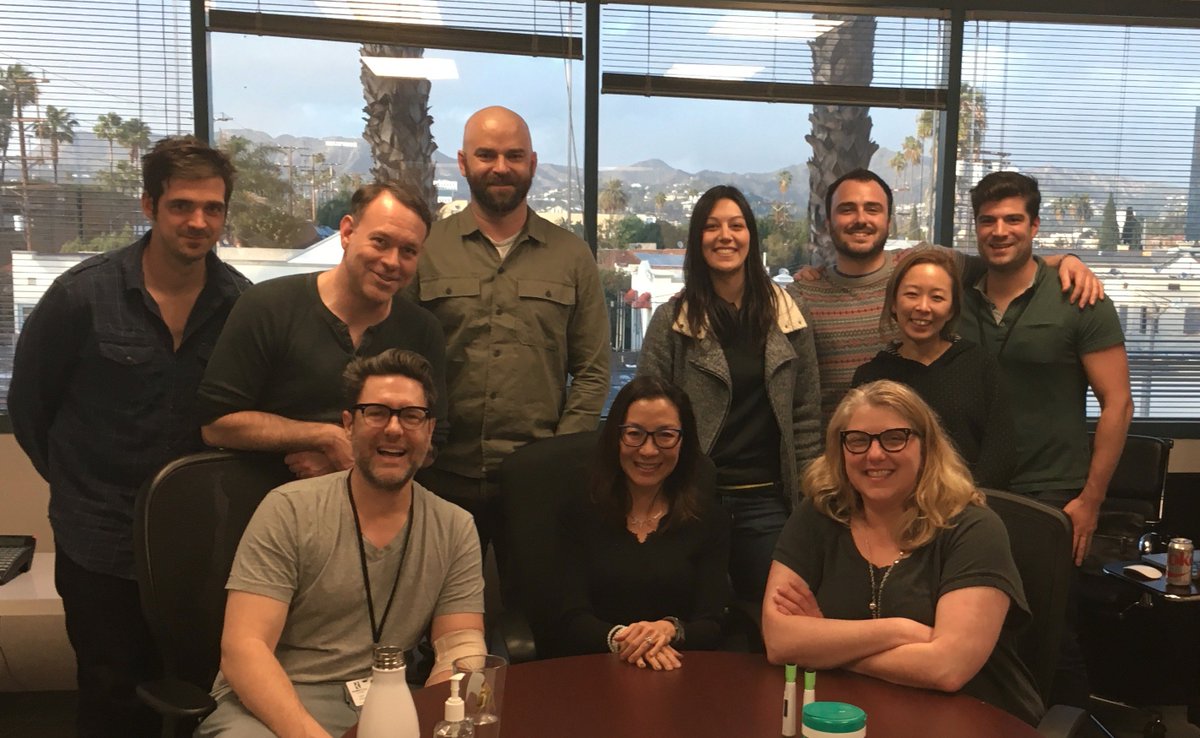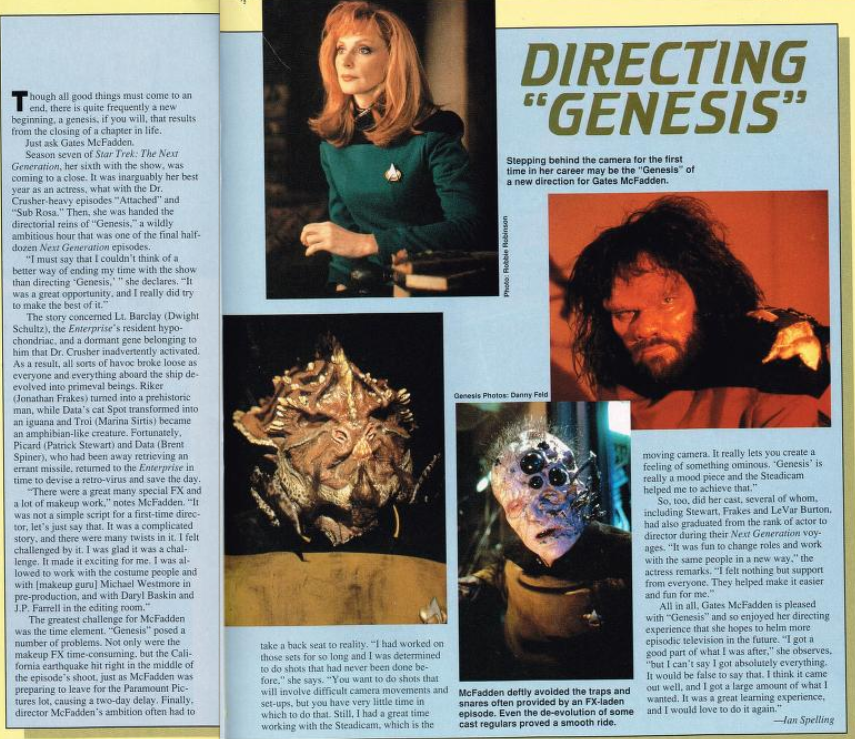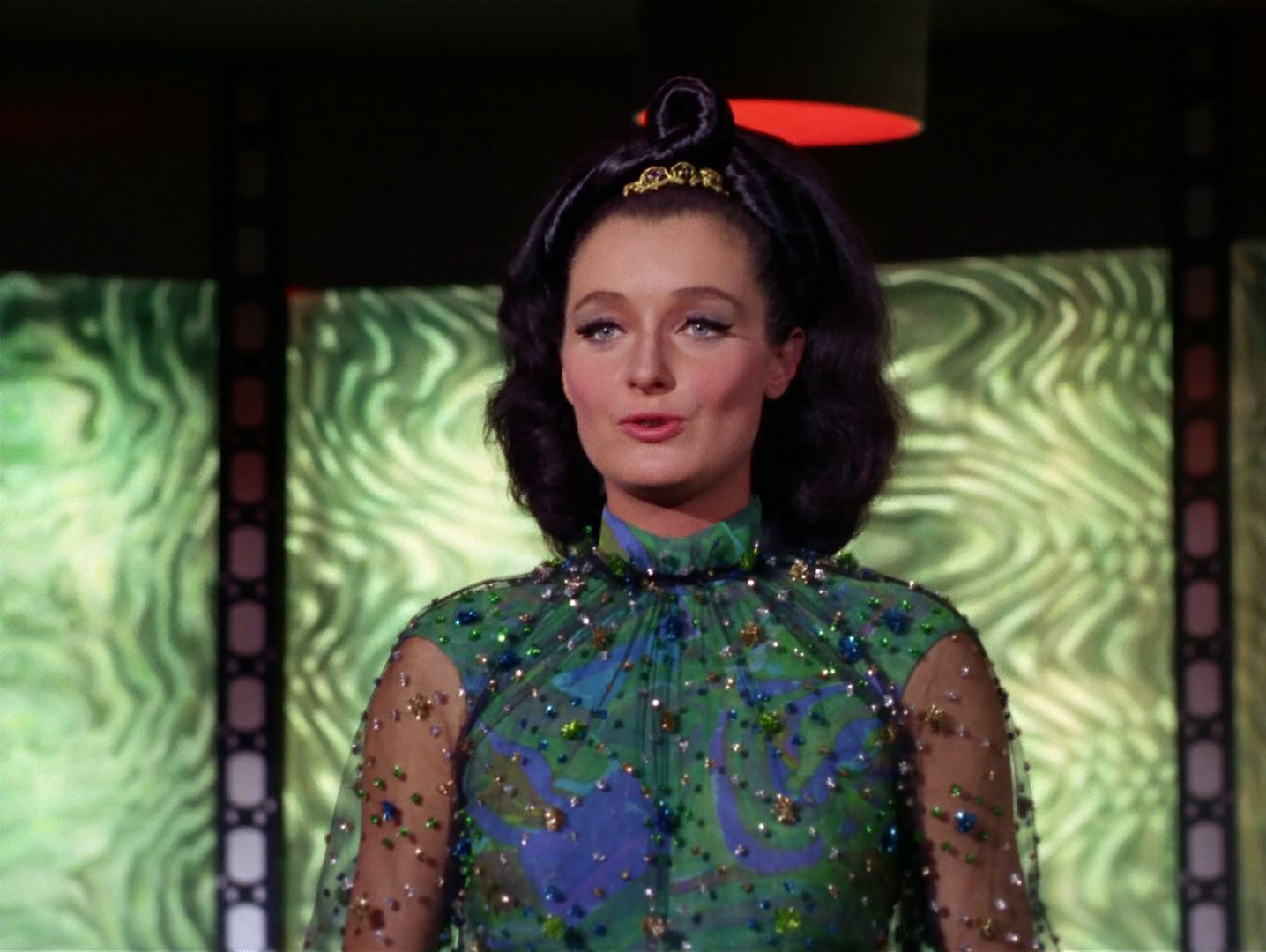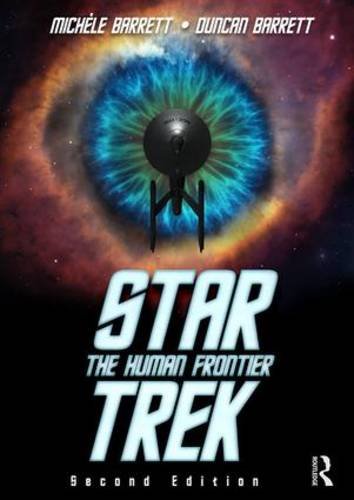Who influences what Star Trek looks like? Who decides who the characters are and what they say? Who’s behind the stories we review and analyze? Actors are the most visible face of Star Trek, but there are so many people behind the cameras who influence what we end up seeing on screen.
In 2013 when I first started this blog I did a gender breakdown of the people in some of the major “clout positions” or “above the line positions” from The Original Series to Enterprise: executive producers (including showrunners), producers, directors, writers and cinematographers. Results for directors were posted here, and all other positions were posted here.
The results weren’t great. Only 6 women worked as directors on Trek from TOS to ENT, accounting for 35 out of 694 episodes. For example, Enterprise had the highest number of episodes directed by women: 10.3% (all directed by Roxann Dawson). Not a single woman was credited for writing in the entire seventh season of Deep Space Nine. No women worked as cinematographers and men dominated in all other positions.
Now, almost a decade after I first crunched the pre-streaming-era numbers, I wondered if we’d be able to see a shift with new live-action Star Trek (Discovery, Picard and Lower Decks), in the same way that we’ve seen significantly more diversity on screen.
Results

I decided to run the numbers for the three new live action series together instead of separately, because Discovery, Picard and Strange New Worlds have far fewer episodes per season (and thus much smaller sample sizes) and because they have all been produced in a similar era, with overlap in their production teams.
Caveat: I don’t work in the film industry and my goal in running these numbers is not to set threshold goals, but to fuel conversation. For example I analyze writing credits by episode because episodes are often written by teams and just adding all names together over a season or series wouldn’t necessarily show how many episodes women writers got to influence. That said, the TV production context wouldn’t be very conducive to applying targets on an episode-by-episode basis.
Ultimately I want to know that people of all genders, as well as BIPOC and LGBTQIAP+ folks and people with disabilities get to influence what Star Trek looks like and what it says. Gender is the easiest dimension to analyze because easily obtainable biographical information doesn’t always include race, sexual orientation or (dis)ability, but I will mention a few notable people with clout in these other groups. To the best of my knowledge, there have been no non-binary directors, producers, writers, or cinematographers in Trek to date.
I have not yet looked at stats for Lower Decks or Prodigy and did not include them here because some production roles aren’t 100% equivalent for live-action vs. animated series.
Executive Producers
The Center for the Study of Women in Television and Film noted in their 2018-19 “Boxed In” report (PDF) that programs with at least 1 woman executive producer featured more women in speaking roles and major roles, and in other key behind-the-scenes positions, than in programs with exclusively male executive producers.
Pre-Discovery the only woman to be credited as a Star Trek executive producer was Jeri Taylor on 93 episodes of Voyager. It’s also worth noting that all the Executive Producers were white.
Discovery had a fair share of turnover in its executive producers/showrunners in the first couple of years. Still, out of the 15 people credited over four years, there are 4 women (26.7%): Heather Kadin, Gretchen J. Berg, Jenny Lumet and the current co-showrunner Michelle Paradise, an out lesbian who champions diversity in the show.
Heather Kadin has been the only executive producer credited on Star Trek: Picard out of 11, which is not great. Still it’s notable that Kirsten Beyer does have a “created by” credit for Picard, becoming only the second woman in Trek since Jeri Taylor for Voyager.
Jenny Lumet follows this up with a “created by” credit for Strange New Worlds, alongside Akiva Goldsman and Alex Kurtzman. Jenny Lumet comes from a mixed-race background and has a history of working for diversity in film and TV, including generating the Writers Guild of America East’s first Diversity Caucus.
Strange New Worlds credits 10 executive producers in its first season, including Kadin and Lumet (20%).
How does this compare to the industry? The Center for the Study of Women in Television and Film found that in the 2020-21 TV season women made up 31% of Executive Producers across platforms (Source: PDF report).
Producers
In my original breakdowns I mentioned highlights in terms of “key production staff,” including various categories of producers, production and pre-production associates, script consultants and story editors. I looked at a bigger pool of positions and didn’t do a full breakdown of numbers, given the challenge of sorting through the various roles and many individuals who filled them.
Looking at our current era of Trek I stuck to the next three rungs on the hierarchy below the executive producer: the co-executive producer, supervising producer, and producer. I didn’t employ weighting for how many episodes each person was involved in, so the percentage is derived from taking the total women divided by the total individuals in these positions. For Discovery, because we have 50+ episodes total, I didn’t count anyone who worked on fewer than 5 episodes.
| Series | % women producers |
|---|---|
| Discovery | 35.4% (11/31) |
| Picard | 42.1% (8/19) |
| Strange New Worlds | 41.6% (5/12) |
If we go back to the report from the Center for the Study of Women in Television and Film, women accounted for 42% of producers, with slightly higher numbers in broadcast compared to streaming programs.
Writers
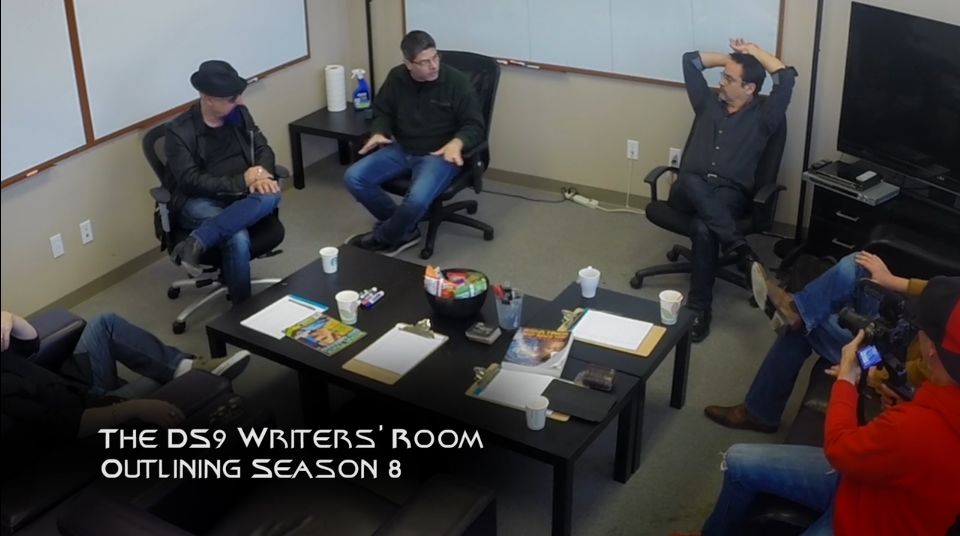
Back when I did the analysis for the pre-streaming Treks, I only counted whether episodes were written by all men, or had at least one credited woman writer. At the time that made sense to me because I just wanted to show how many episodes were influenced by women, not to establish that crediting at least one woman was the bar to aspire to. But in updating my approach I wanted to break out the data in a more meaningful way, noting those written by all women and all men, as well as those by mixed-gender writing teams.
As with my first set of data, I counted everyone with credit for story, teleplay or writing in this category.
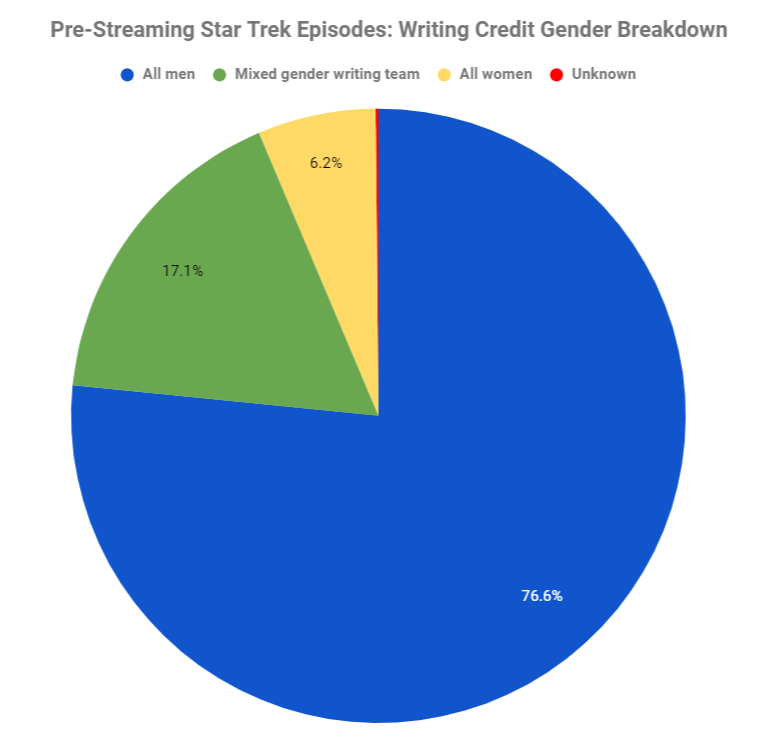
In the pre-streaming era, 76.6% of Star Trek episodes only credited men. 17.1% credited a mix of gender. 6.2% credited all women. There is also one unknown writer gender: L.J. Strom, who holds the story credit for the DS9 episode “Rapture.” I didn’t break out each pre-streaming series for these results because it wasn’t just TOS that wasn’t great (TNG was actually the best, with a low of 69.8% of episodes crediting only men), but you can see my original breakdowns by series here.
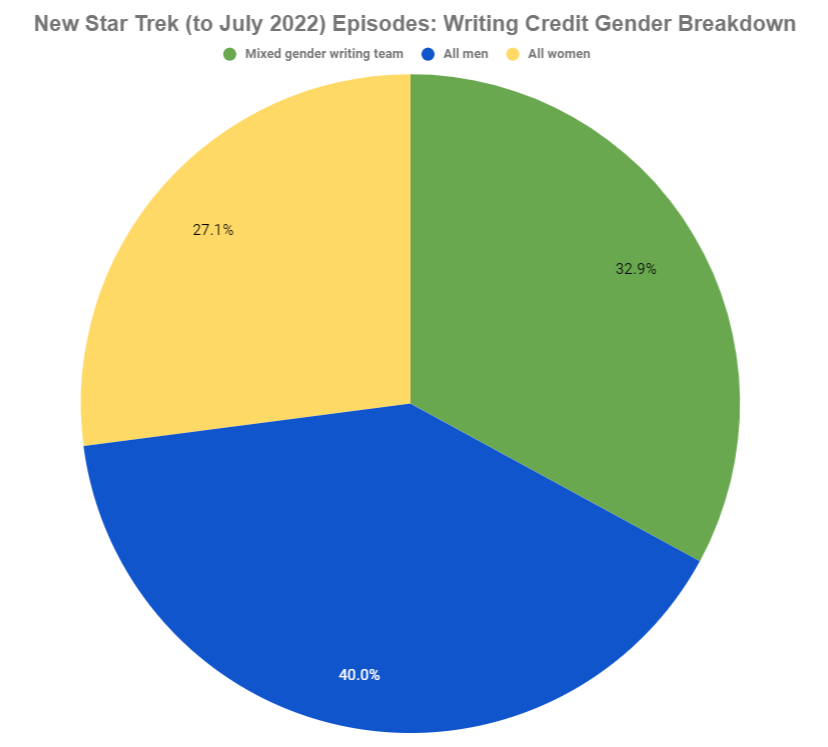
Here we see a 36.6% shift away from episodes that only credit male writers to episodes that credit all women (27.1%) or a mixed-gender writing team (32.9%), compared to the pre-streaming era.
According to the Writers Guild of America (PDF report), in 2020 women made up 45.3% of TV series writers and 35.2% of development/pilot writers. Because I determined my data by episode, I can’t make a direct comparison to the WGA numbers, but my guess is that Trek would come out roughly comparable.

Directors

From 2017 to 2022 65.9% of episodes were directed by men and 34.1% were directed by women. This is a notable increase from our pre-streaming high of 10.3%. Star Trek: Discovery alone more than doubled the number of women who’d directed an episode of Star Trek: from 6 to 15.
Still it seems like Star Trek is reflecting a broader trend instead of leading the pack here. According to the Directors Guild of America, of more than 4,300 episodes produced in the 2019-20 TV season, 34% were directed by women.
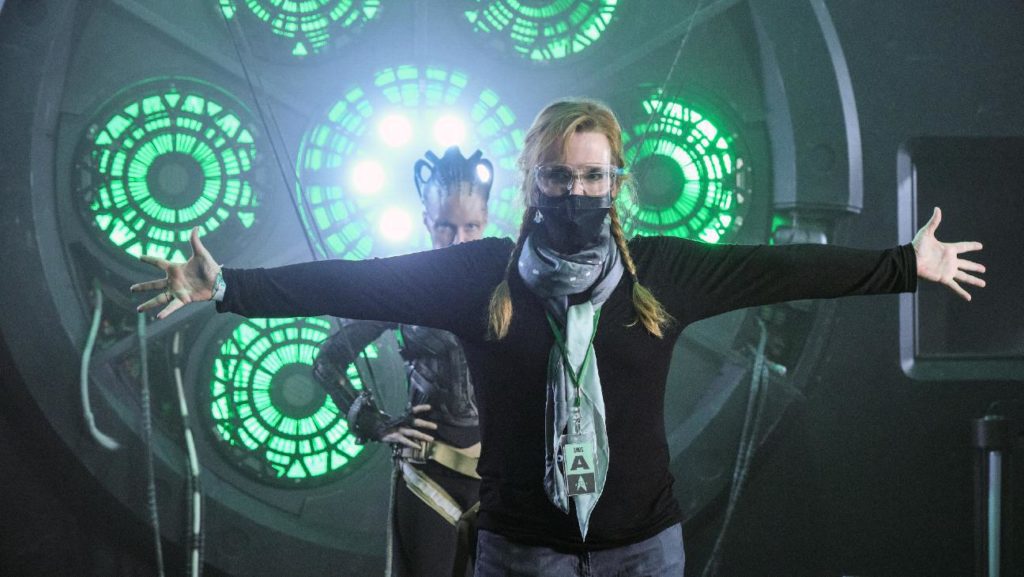
Cinematographers
In the pre-streaming era, Star Trek had never had a woman cinematographer. In the streaming era the dial has moved, but only slightly, and only very recently, with Magdalena Górka’s work on five episodes of Strange New Worlds. It’s worth noting that cinematography isn’t always considered an “above the line” position, but that doesn’t mean the significant gender gap isn’t a cause for concern.
Firsts
Even after fifty years of Star Trek there were new glass ceilings to be shattered.
As noted above, just this year Magdalena Górka became the Star Trek’s first woman cinematographer. ASC Magazine has a great interview with her if you want to learn more about that experience.
One woman I wanted to highlight outside the list of clout positions is composer Nami Melumad, who became the first woman to score a Star Trek episode, the Short Treks episode “Q&A”, and then the first woman to score a Star Trek series: Prodigy. You also have her to thank for the weekly episode scoring on Strange New Worlds.

In 2019 Hanelle Culpepper became the first woman director to launch a new series, with Star Trek: Picard. She was also the first Black woman to direct Star Trek, starting with the Season 1 Discovery episode “Vaulting Ambition.” Take a listen to our Women at Warp interview with Culpepper if you haven’t already.
Conclusion
There’s been a sea change in the representation of women both on screen and behind the scenes since the beginning of streaming-era Star Trek. Compared to pre-streaming Trek, women hold significantly more clout positions behind the scenes on live-action Star Trek productions today. It’s no longer hard to find examples of women influencing not just the content of single episodes, but also the vision of entire series.
We’re also still celebrating new “firsts” as women take on new behind-the-scenes roles for the first time in Trek history. Going forward we can hope to see more firsts from women, BIPOC and LGBTQIAP+ folks, and people with disabilities. For example we can hope to see non-binary people in some of these roles just as we now have on-screen non-binary representation in Discovery.
Still, when you compare the numbers for Star Trek against the industry, it feels likely that the behind-the-scenes makeup of the franchise simply reflects broader trends. In some cases, as with executive producers and other key production staff, Trek lags behind the pack in terms of women’s representation. With three ongoing live-action series and rumors of more to come, there’s a golden opportunity for Star Trek to carve out space as a leader in behind-the-scenes diversity, as it has in on-screen diversity.
Let’s fly.







